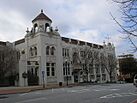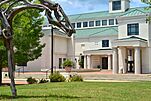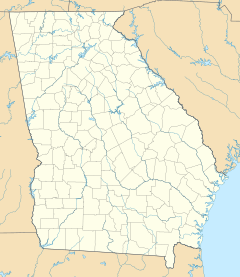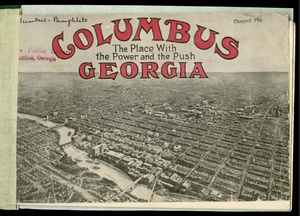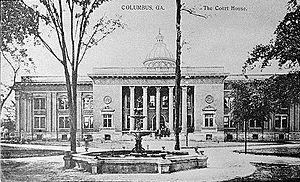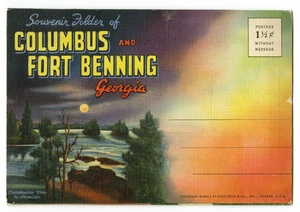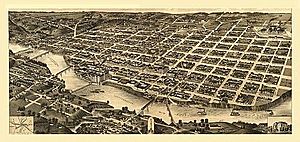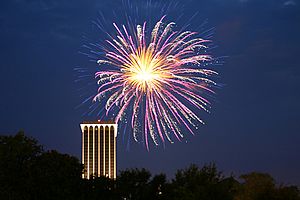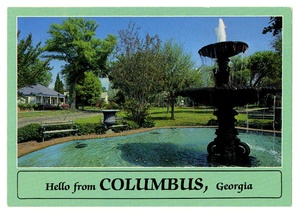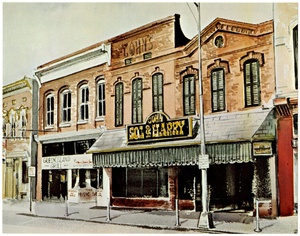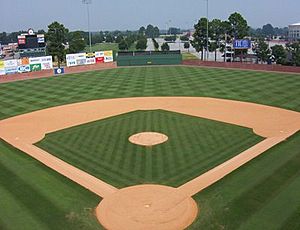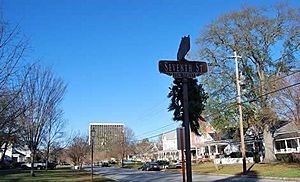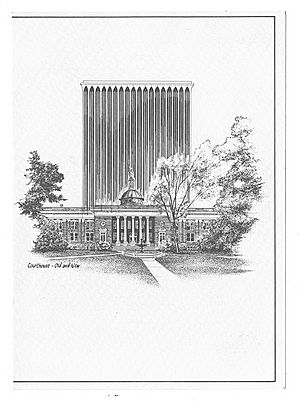Columbus, Georgia facts for kids
Quick facts for kids
Columbus, Georgia
|
|||||
|---|---|---|---|---|---|
|
Consolidated city-county
|
|||||
|
Downtown skyline on the banks of the Chattahoochee River
Ledger-Enquirer Building
The Liberty Theatre
Central of Georgia Railroad Terminal
First African Baptist Church
Columbus Museum
|
|||||
|
|||||
| Nicknames:
The Fountain City or The Lowell of the South
|
|||||
| Motto(s):
"We Do Amazing"
|
|||||
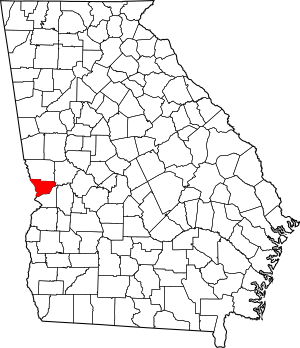
Location within Georgia
|
|||||
| Country | |||||
| State | |||||
| County | Muscogee | ||||
| Founded | 1828 | ||||
| Named for | Christopher Columbus | ||||
| Area | |||||
| • Consolidated city-county | 221.01 sq mi (572.42 km2) | ||||
| • Land | 216.50 sq mi (560.73 km2) | ||||
| • Water | 4.51 sq mi (11.68 km2) | ||||
| Elevation | 243 ft (74 m) | ||||
| Population
(2020)
|
|||||
| • Consolidated city-county | 206,922 | ||||
| • Rank | 112th in the United States 2nd in Georgia |
||||
| • Density | 955.76/sq mi (369.02/km2) | ||||
| • Urban | 267,746 (US: 153rd) | ||||
| • Urban density | 1,874.2/sq mi (723.6/km2) | ||||
| • Metro | 328,883 (US: 157th) | ||||
| Demonym(s) | Columbusite | ||||
| Time zone | UTC−5 (EST) | ||||
| • Summer (DST) | UTC−4 (EDT) | ||||
| ZIP codes |
31820, 31829, 31900–09, 31914, 31917, 31993–94, 31997–99
|
||||
| Area code(s) | 706, 762 | ||||
| FIPS code | 13-19007 | ||||
| GNIS feature ID | 0331158 | ||||
| Airport | Columbus Airport (CSG) | ||||
Columbus is a consolidated city-county located on the west-central border of the U.S. state of Georgia. Columbus lies on the Chattahoochee River directly across from Phenix City, Alabama. It is the county seat of Muscogee County, with which it officially merged in 1970; the original merger excluded Bibb City, which joined in 2000 after dissolving its own city charter.
Columbus is the second most populous city in Georgia (after Atlanta), and fields the state's fourth-largest metropolitan area. At the 2020 U.S. census, Columbus had a population of 206,922, with 328,883 in the Columbus metropolitan statistical area. The metro area joins the nearby Alabama cities of Auburn and Opelika to form the Columbus–Auburn–Opelika combined statistical area, which had a population of 563,967 in 2020.
Columbus lies 100 miles (160 km) southwest of Atlanta. Fort Moore, formerly Fort Benning, the United States Army's Maneuver Center of Excellence and a major employer, is located south of the city in southern Muscogee and Chattahoochee counties. Columbus is home to museums and tourism sites, including the National Infantry Museum, dedicated to the U.S. Army's Infantry Branch. It has the longest urban whitewater rafting course in the world constructed on the Chattahoochee River.
Contents
History
Beginnings
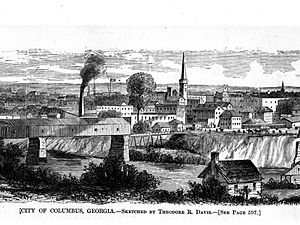
This was for centuries the traditional territory of the Creek Indians, who became known as one of the Five Civilized Tribes of the Southeast after European contact. Those who lived closest to white-occupied areas conducted considerable trading and adopted some European-American ways.
Founded in 1828 by an act of the Georgia Legislature, Columbus was situated at the beginning of the navigable portion of the Chattahoochee River and on the last stretch of the Federal Road before entering Alabama. The city was named for Christopher Columbus. The plan for the city was drawn up by Dr. Edwin L. DeGraffenried, who placed the town on a bluff overlooking the river. Across the river to the west, where Phenix City, Alabama, is now located, lived several tribes of the Creek and other Georgia and Alabama indigenous peoples. Most Creeks moved west with the 1826 Treaty of Washington. Those who stayed and made war were forcibly removed in 1836.
The river served as Columbus's connection to the world, particularly enabling it to ship its commodity cotton crops from the plantations to the international cotton market via New Orleans and ultimately Liverpool, England. The city's commercial importance increased in the 1850s with the arrival of the railroad. In addition, textile mills were developed along the river, bringing industry to an area reliant upon agriculture. By 1860, the city was one of the more important industrial centers of the South, earning it the nickname the Lowell of the South, referring to an important textile mill town in Massachusetts.
Civil War and Reconstruction
When the Civil War broke out in 1861, the industries of Columbus expanded their production; this became one of the most important centers of industry in the Confederacy. During the war, Columbus ranked second to Richmond in the manufacture of supplies for the Confederate army. The Eagle Manufacturing Company made various textiles, especially woolens for Confederate uniforms. The Columbus Iron Works manufactured cannons and machinery for the nearby Confederate Navy shipyard, Greenwood and Gray made firearms, and Louis and Elias Haimon produced swords and bayonets. Smaller firms provided additional munitions and sundries. As the war turned in favor of the Union, each industry faced exponentially growing shortages of raw materials and skilled labor, as well as worsening financial opportunities.
Unaware of Lee's surrender to Grant and the assassination of Abraham Lincoln, Union and Confederates clashed in the Battle of Columbus, Georgia, on Easter Sunday, April 16, 1865, when a Union detachment of two cavalry divisions under Maj. Gen. James H. Wilson attacked the lightly defended city and burned many of the industrial buildings. John Stith Pemberton, who later developed Coca-Cola in Columbus, was wounded in this battle. Col. Charles Augustus Lafayette Lamar, owner of the last slave ship in America, was also killed here. A historic marker erected in Columbus notes that this was the site of the "Last Land Battle in the War from 1861 to 1865".
Reconstruction began almost immediately and prosperity followed. Factories such as the Eagle and Phenix Mills were revived and the industrialization of the town led to rapid growth, causing the city to outgrow its original plan. The Springer Opera House was built during this time, attracting such notables as Irish writer Oscar Wilde. The Springer is now the official State Theater of Georgia.
By the time of the Spanish–American War, the city's modernization included the addition of a new waterworks, as well as trolleys extending to outlying neighborhoods such as Rose Hill and Lakebottom. Mayor Lucius Chappell also brought a training camp for soldiers to the area. This training camp, named Camp Benning, grew into present-day Fort Benning, named for General Henry L. Benning, a native of the city. Fort Benning was one of the ten U.S. Army installations named for former Confederate generals that were renamed on 11 May 2023, following a recommendation from the congressionally mandated Naming Commission that Fort Benning be renamed Fort Moore after Lieutenant General Hal Moore and his wife Julia Compton Moore, both of whom are buried on post.

Confederate Memorial Day
In the spring of 1866, the Ladies Memorial Association of Columbus passed a resolution to set aside one day annually to memorialize the Confederate dead. The secretary of the association, Mary Ann Williams, was directed to write a letter inviting the ladies of every Southern state to join them in the observance. The letter was written in March 1866 and sent to representatives of all of the principal cities in the South, including Atlanta, Macon, Montgomery, Memphis, Richmond, St. Louis, Alexandria, Columbia, and New Orleans. This was the beginning of the influential work by ladies' organizations to honor the war dead.
The date for the holiday was selected by Elizabeth Rutherford Ellis. She chose April 26, the first anniversary of Confederate General Johnston's final surrender to Union General Sherman at Bennett Place, North Carolina. For many in the South, that act marked the official end of the Civil War.
In 1868, General John A. Logan, commander in chief of the Union Civil War Veterans Fraternity called the Grand Army of the Republic, launched the Memorial Day holiday that is now observed across the entire United States. General Logan's wife said he had borrowed from practices of Confederate Memorial Day. She wrote that Logan "said it was not too late for the Union men of the nation to follow the example of the people of the South in perpetuating the memory of their friends who had died for the cause they thought just and right."
While two dozen cities across the country claim to have originated the Memorial Day holiday, Bellware and Gardiner firmly establish that the holiday began in Columbus. In The Genesis of the Memorial Day Holiday in America, they show that the Columbus Ladies Memorial Association's call to observe a day annually to decorate soldiers' graves inaugurated a movement first in the South and then in the North to honor the soldiers who died during the Civil War.
20th century
With the expansion of the city, leaders established Columbus College, a two-year institution, which later evolved into Columbus State University, now a comprehensive center of higher learning and part of the University System of Georgia.
The city government and the county consolidated in 1971, the first such consolidation in Georgia and one of only 16 in the U.S. at the time.
Expanding on its industrial base of textile mills, the city is the home of the headquarters for Aflac, Synovus, and TSYS.
From the 1960s through the 1980s, the subsidized construction of highways and suburbs resulted in drawing off the middle and upper classes. Early efforts to halt the gradual deterioration of downtown began with the saving and restoration of the Springer Opera House in 1965. It was designated as the State Theatre of Georgia, helping spark a movement to preserve the city's history. This effort has documented and preserved various historic districts in and around downtown.
Through the late 1960s and early 1970s, large residential neighborhoods were built to accommodate the soldiers coming back from the Vietnam War and for those associated with Fort Benning. These range from Wesley Woods to Leesburg to Brittney and Willowbrook and the high-end Sears Woods and Windsor Park. Large tracts of blighted areas were cleaned up. A modern Columbus Consolidated Government Center was constructed in the city center. A significant period of urban renewal and revitalization followed in the mid- to late 1990s.
With these improvements, the city has attracted residents and businesses to formerly blighted areas. Municipal projects have included construction of a softball complex, which hosted the 1996 Olympic softball competition; the Chattahoochee RiverWalk; the National Civil War Naval Museum at Port Columbus; and the Coca-Cola Space Science Center. Other notable projects were the expansion of the Columbus Museum and road improvements to include a new downtown bridge crossing the Chattahoochee River and into Phenix City. During the late 1990s, commercial activity expanded north of downtown along the I-185 corridor.
21st century
During the 2000s, the city began a major initiative to revitalize the downtown area. The project began with the South Commons, an area south of downtown containing the softball complex, A. J. McClung Memorial Stadium, Golden Park, the Columbus Civic Center, and the Jonathan Hatcher Skateboard Park. The National Infantry Museum was constructed in South Columbus, located outside the Fort Benning main gate.
In 2002, Columbus State University, which previously faced expansion limits due to existing residential and commercial districts surrounding it, began a second campus downtown, starting by moving the music department into the newly-opened RiverCenter for the Performing Arts. The university's art, drama, and nursing departments also moved to downtown locations. Such initiatives have provided Columbus with a cultural niche; downtown features modern architecture mixed among older brick facades.
The Ready to Raft 2012 project created an estimated 700 new jobs and is projected to bring in $42 million annually to the Columbus area. Demolishing an up-river dam allowed the project to construct the longest urban whitewater rafting course in the world. According to the Columbus Convention and Visitors Bureau, this initiative, in addition to other outdoor and indoor tourist attractions, led to around 1.8 million visitors coming to Columbus during the city's 2015 fiscal year.
The city predicts that an additional 30,000 soldiers will be trained annually at Fort Benning in upcoming years due to base realignment and closure of other facilities. As a result, Columbus is expected to experience a major population increase.
Geography
Columbus is one of Georgia's three Fall Line Cities, along with Augusta and Macon. The Fall Line is where the hilly lands of the Piedmont plateau meet the flat terrain of the coastal plain. As such, Columbus has a varied landscape of rolling hills on the north side and flat plains on the south. The fall line causes rivers in the area to decline rapidly towards sea level. Textile mills were established here in the 19th and early 20th centuries to take advantage of the water power from the falls.
Interstate 185 runs north-south through the middle of the city, with nine exits within Muscogee County. I-185 runs north about 50 mi (80 km) from its beginning to a junction with I-85 just east of LaGrange and about 60 mi (97 km) southwest of Atlanta. U.S. Route 27, U.S. Route 280, and Georgia State Route 520 (known as South Georgia Parkway) all meet in the interior of the city. U.S. Route 80 runs through the northern part of the city, locally known as J.R. Allen Parkway; Alternate U.S. Route 27 and Georgia State Route 85 run northeast from the city, locally known as Manchester Expressway.
The city is located at 32°29′23″N 84°56′26″W / 32.489608°N 84.940422°W.
According to the US Census Bureau, the city has a total area of 221.0 square miles (572 km2), of which 216.3 square miles (560 km2) are land and 4.7 square miles (12 km2) (2.14%) are covered by water.
Columbus borders Phenix City, its largest suburb (in Alabama). Columbus also borders Chattahoochee, Talbot, Harris, and Russell County, which is in Alabama.
Climate
Columbus has a humid subtropical climate (Köppen Cfa). Daytime summer temperatures often reach highs in the mid-90°Fs, and low temperatures in the winter average in the upper 30s. Columbus is often considered a dividing line or "natural snowline" of the southeastern United States with areas north of the city receiving snowfall annually, with areas to the south typically not receiving snowfall every year or at all. Columbus is within USDA hardiness zone 8b in the city center and zone 8a in the suburbs.
| Climate data for Columbus Metropolitan Airport, Georgia (1991–2020 normals, extremes 1891–present) | |||||||||||||
|---|---|---|---|---|---|---|---|---|---|---|---|---|---|
| Month | Jan | Feb | Mar | Apr | May | Jun | Jul | Aug | Sep | Oct | Nov | Dec | Year |
| Record high °F (°C) | 84 (29) |
84 (29) |
92 (33) |
95 (35) |
100 (38) |
106 (41) |
105 (41) |
104 (40) |
106 (41) |
101 (38) |
88 (31) |
84 (29) |
106 (41) |
| Mean maximum °F (°C) | 73.5 (23.1) |
76.6 (24.8) |
83.8 (28.8) |
87.2 (30.7) |
92.8 (33.8) |
96.5 (35.8) |
98.6 (37.0) |
98.1 (36.7) |
94.7 (34.8) |
88.4 (31.3) |
81.2 (27.3) |
75.2 (24.0) |
99.5 (37.5) |
| Mean daily maximum °F (°C) | 58.7 (14.8) |
63.2 (17.3) |
70.4 (21.3) |
77.7 (25.4) |
85.1 (29.5) |
90.2 (32.3) |
92.9 (33.8) |
91.8 (33.2) |
87.3 (30.7) |
78.3 (25.7) |
68.4 (20.2) |
60.6 (15.9) |
77.0 (25.0) |
| Daily mean °F (°C) | 48.5 (9.2) |
52.3 (11.3) |
58.9 (14.9) |
65.8 (18.8) |
74.1 (23.4) |
80.4 (26.9) |
83.2 (28.4) |
82.4 (28.0) |
77.6 (25.3) |
67.6 (19.8) |
57.3 (14.1) |
50.6 (10.3) |
66.6 (19.2) |
| Mean daily minimum °F (°C) | 38.2 (3.4) |
41.5 (5.3) |
47.3 (8.5) |
54.0 (12.2) |
63.1 (17.3) |
70.5 (21.4) |
73.5 (23.1) |
73.0 (22.8) |
67.9 (19.9) |
56.8 (13.8) |
46.1 (7.8) |
40.6 (4.8) |
56.0 (13.3) |
| Mean minimum °F (°C) | 20.9 (−6.2) |
25.9 (−3.4) |
30.6 (−0.8) |
39.0 (3.9) |
49.3 (9.6) |
61.7 (16.5) |
67.8 (19.9) |
66.1 (18.9) |
55.6 (13.1) |
40.6 (4.8) |
30.4 (−0.9) |
25.5 (−3.6) |
19.2 (−7.1) |
| Record low °F (°C) | −2 (−19) |
−3 (−19) |
16 (−9) |
28 (−2) |
39 (4) |
44 (7) |
59 (15) |
57 (14) |
38 (3) |
24 (−4) |
10 (−12) |
4 (−16) |
−3 (−19) |
| Average precipitation inches (mm) | 4.24 (108) |
4.46 (113) |
4.92 (125) |
4.03 (102) |
3.24 (82) |
4.03 (102) |
4.35 (110) |
4.68 (119) |
3.34 (85) |
2.78 (71) |
3.96 (101) |
4.79 (122) |
48.82 (1,240) |
| Average snowfall inches (cm) | 0.0 (0.0) |
0.0 (0.0) |
0.2 (0.51) |
0.0 (0.0) |
0.0 (0.0) |
0.0 (0.0) |
0.0 (0.0) |
0.0 (0.0) |
0.0 (0.0) |
0.0 (0.0) |
0.0 (0.0) |
0.3 (0.76) |
0.5 (1.3) |
| Average precipitation days (≥ 0.01 in) | 10.2 | 8.9 | 9.4 | 8.0 | 7.8 | 10.4 | 11.8 | 11.2 | 7.0 | 6.5 | 7.3 | 10.2 | 108.7 |
| Average snowy days (≥ 0.1 in) | 0.0 | 0.0 | 0.1 | 0.0 | 0.0 | 0.0 | 0.0 | 0.0 | 0.0 | 0.0 | 0.0 | 0.3 | 0.4 |
| Source: NOAA | |||||||||||||
Cityscape
Columbus is divided into five geographic areas:
- Downtown, also sometimes called "Uptown" (though "Uptown" is actually the title given to both a nonprofit organization operating to encourage area growth and development or "urban renewal" in the city and also to the actual physical area of that development itself, which is an expanding subsection of the downtown district located in the areas from Broadway to the Chattahoochee River) is the city's central business district, and home to multiple historic districts, homes, and churches, such as the Columbus Historic Riverfront Industrial District, the Mott House, and the Church of the Holy Family.
- East Columbus is a predominantly residential area located east of MidTown.
- MidTown is a residential and commercial area located directly east of Downtown; several historic districts have been designated. It is the location of the corporate headquarters of Aflac.
- North Columbus, also called Northside, is a diverse suburban area, home to established neighborhoods and subdivisions, such as Green Island Hills and Oldtown. It has multiple shopping and lifestyle areas.
- South Columbus is situated just south of the MidTown region, and directly north of Fort Benning. It is the site of the National Infantry Museum, honoring the history of infantry forces in the U.S. Army. The museum was located here in an effort to introduce jobs and attract visitors to stimulate a variety of activities. It has had bars, honky tonks, and other businesses that appeal to young male soldiers from Fort Benning.
Surrounding cities and towns
The Columbus Metropolitan Area includes four counties in Georgia, and one in Alabama. The Columbus-Auburn-Opelika, GA-AL Combined Statistical Area includes two additional counties in Alabama. A 2013 Census estimate showed 316,554 in the metro area, with 501,649 in the combined statistical area.
Demographics
| Historical population | |||
|---|---|---|---|
| Census | Pop. | %± | |
| 1830 | 1,152 | — | |
| 1840 | 3,114 | 170.3% | |
| 1850 | 5,942 | 90.8% | |
| 1860 | 9,621 | 61.9% | |
| 1870 | 7,401 | −23.1% | |
| 1880 | 10,123 | 36.8% | |
| 1890 | 17,303 | 70.9% | |
| 1900 | 17,614 | 1.8% | |
| 1910 | 20,554 | 16.7% | |
| 1920 | 31,125 | 51.4% | |
| 1930 | 43,131 | 38.6% | |
| 1940 | 53,280 | 23.5% | |
| 1950 | 79,611 | 49.4% | |
| 1960 | 116,779 | 46.7% | |
| 1970 | 155,028 | 32.8% | |
| 1980 | 169,441 | 9.3% | |
| 1990 | 178,681 | 5.5% | |
| 2000 | 185,781 | 4.0% | |
| 2010 | 189,885 | 2.2% | |
| 2020 | 206,922 | 9.0% | |
| U.S. Decennial Census 1990 2000 2010 2020 |
|||
| Race / Ethnicity (NH = Non-Hispanic) | Pop 2000 | Pop 2010 | Pop 2020 | % 2000 | % 2010 | % 2020 |
|---|---|---|---|---|---|---|
| White alone (NH) | 90,200 | 82,890 | 79,083 | 48.55% | 43.65% | 38.22% |
| Black or African American alone (NH) | 80,698 | 85,119 | 94,701 | 43.44% | 44.83% | 45.77% |
| Native American or Alaska Native alone (NH) | 614 | 599 | 488 | 0.33% | 0.32% | 0.24% |
| Asian alone (NH) | 2,788 | 4,061 | 5,546 | 1.50% | 2.14% | 2.68% |
| Pacific Islander alone (NH) | 248 | 378 | 517 | 0.13% | 0.20% | 0.25% |
| Some Other Race alone (NH) | 297 | 432 | 1,076 | 0.16% | 0.23% | 0.52% |
| Mixed Race or Multi-Racial (NH) | 2,568 | 4,296 | 8,998 | 1.38% | 2.26% | 4.35% |
| Hispanic or Latino (any race) | 8,368 | 12,110 | 16,513 | 4.50% | 6.38% | 7.98% |
| Total | 185,781 | 189,885 | 206,922 | 100.00% | 100.00% | 100.00% |
Since the 1830 United States census, Columbus has maintained a relatively positive population growth. At the 2020 census, there were 206,922 people, 73,134 households, and 45,689 families residing in the city. At the 2010 census, Columbus had a total population of 189,885, up from 186,291 in the 2000 census. The 2010 census reported 189,885 people, 72,124 households, and 47,686 families residing in the city. The population density was 861.4 inhabitants per square mile (332.6/km2). The 82,690 housing units had an average density of 352.3 per square mile (136.0/km2).
In 2010, the racial and ethnic composition of the city was 46.3% White, 45.5% African American, 2.2% Asian, 0.2% Native American, 0.14% Pacific Islander, and 1.90% from other races. Hispanics or Latinos of any race were 6.4% of the population. In 2020, its population was 38.22% non-Hispanic white, 45.77% African American, 0.24% Native American, 2.68% Asian, 0.25% Pacific Islander, 0.52% some other race, 4.35% multiracial, an 7.98% Hispanic or Latino of any race.
At the 2010 census, median income for a household in the city was $41,331, and for a family was 41,244. Males had a median income of $30,238 versus $24,336 for females. The per capita income for the city was $22,514. About 12.8% of families and 15.7% of the population were below the poverty line, including 22.0% of those under age 18 and 12.1% of those age 65 or over. According to the 2022 American Community Survey, the median household income throughout the city was $53,750 with a per capita income of $31,393. Approximately 17.8% of the population lived at or below the poverty line.
There is a Mexican community in the city.
Economy
Companies headquartered in Columbus include Aflac, TSYS, Realtree, Synovus and the W. C. Bradley Co.
Top employers
According to Columbus' 2022 Comprehensive Annual Financial Report, the top employers in the city were:
| # | Employer | # of employees |
|---|---|---|
| 1 | Fort Moore | 45,320 |
| 2 | Muscogee County School District | 5,500 |
| 3 | TSYS | 4,075 |
| 4 | Aflac | 3,335 |
| 5 | Columbus Consolidated Government | 2,811 |
| 6 | Columbus Regional Healthcare System | 2,430 |
| 7 | The Pezold Companies/McDonalds | 2,000 |
| 8 | Pratt & Whitney | 1,850 |
| 9 | St. Francis Hospital, Inc. | 1,735 |
| 10 | Blue Cross Blue Shield of Georgia (part of Anthem) | 1,650 |
Arts and culture
Points of interest
Museums
- Founded in 1953, the Columbus Museum (accredited by the American Alliance of Museums) contains artifacts of regional history and works of American art. It mounts displays from its permanent collection, as well as temporary exhibitions. It is the largest art and history museum in Georgia.
- Moved from its previous location in Lumpkin, Columbus is now home to Historic Westville. With 17 buildings currently on site and interpreters throughout the village (such as a blacksmith and carpenter), guests can to go on self-guided tours learning about the homes and crafts of the 19th century.
- The National Civil War Naval Museum at Port Columbus is a 40,000-square-foot (3,700 m2) facility that opened in 1962. It features two original Civil War military vessels, uniforms, equipment, and weapons used by the Union and Confederate navies.
- The Coca-Cola Space Science Center opened in 1996 for the purpose of public education in science, physics, and astronomy. It includes four flight simulators and a planetarium.
- The National Infantry Museum and Soldier Center opened in June 2009, and includes displays related to the history of the infantry from the founding of the nation to the present. Its IMAX theatre shows related films and special productions.
- The Bo Bartlett Center is a 18,000+ square foot museum and gallery space. The venue features a permanent display of large-scale paintings by Columbus native Bo Bartlett, as well as rotating exhibitions by renowned contemporary artists.
- The W.C. Bradley Museum is an 11,000 square foot art museum that features the art collection of the W.C. Bradley Company. Notable artists in the collection include Bo Bartlett and Garry Pound.
Shopping
Columbus is served by one major indoor shopping mall, Peachtree Mall, which is anchored by major department stores Dillard's, Macy's, and J.C. Penney. The total retail floor area is 821,000 f2t (76,300 m2). Major strip malls include Columbus Park Crossing, which opened in 2003, and The Landings, which opened in 2005. Columbus is also served by The Shoppes at Bradley Park, a lifestyle center.
MidTown contains two of the city's early suburban shopping centers (the Village on 13th and St. Elmo), both recently renovated and offering local shops, restaurants, and services.
Major venues
Major venues in the city of Columbus:
- A. J. McClung Memorial Stadium, a football stadium, was the site of the football games between the Georgia Bulldogs and the Auburn Tigers (the Deep South's Oldest Rivalry) from 1916 to 1958. It became the home of college football's Pioneer Bowl in December 2010, and hosts annual rivalry games between Tuskegee University and Morehouse College, as well as between Albany State University and Fort Valley State University.
- The Bradley Theater, a performance theatre, was opened in mid-1940 by Paramount Pictures.
- Columbus Civic Center, a 10,000-seat multi-purpose arena, opened in 1996. It is the primary arena used for concert and professional sporting events in Columbus. The Columbus Lions indoor football team and Columbus River Dragons ice hockey team both call the Civic Center home.
- Synovus Park, a 5,000 seat baseball stadium, was the former home to the Columbus Catfish and the minor-league Columbus Redstixx, and as of June 2021, is the host stadium of the Columbus Chatt-A-Hoots. It was also the site of the softball events of the 1996 Summer Olympics. It opened in 1926, making it the oldest baseball park in the city.
- RiverCenter for the Performing Arts, a 2,000-seat modern performance theatre, first opened in 2002 and is operated by the Columbus nonprofit organization RiverCenter Inc. It is commonly used for local events, and occasionally used for nationally recognized performances.
- Springer Opera House, a historic live performance theater located in downtown, opened in early 1871. Former United States President Jimmy Carter proclaimed it the State Theatre of Georgia for the 1971–72 season. The legislature made the designation permanent in 1992.
Historic districts
Columbus is home to nine historic districts, all listed in the National Register of Historic Places listings in Muscogee County, Georgia. They are:
- Bibb City Historic District
- Columbus Historic District
- Columbus Historic Riverfront Industrial District
- Dinglewood Historic District
- Peacock Woods-Dimon Circle Historic District
- Weracoba-St. Elmo Historic District
- Wynn's Hill-Overlook-Oak Circle Historic District
- Wynnton Village Historic District
- Waverly Terrace Historic District
Sports
| Club | Sport | League | Venue |
|---|---|---|---|
| Columbus Lions | Indoor football | National Arena League | Columbus Civic Center |
| Columbus River Dragons | Hockey | Federal Prospects Hockey League | Columbus Civic Center |
| Columbus United | Soccer | National Premier Soccer League | Kinnett Stadium |
| Columbus Elite | Soccer | United Premier Soccer League | Harris County Soccer Complex |
| Fountain City FC | Soccer | United Premier Soccer League | Otis Spencer Stadium & Kinnett Stadium |
| Columbus Clingstones (2025) | Baseball | Southern League | Synovus Park |
Columbus Northern Little League won the 2006 Little League World Series, defeating the team from Kawaguchi, Japan in the championship. Current MLB player Josh Lester was a member of the championship team.
Parks and recreation
Columbus is home to upwards of 50 parks, four recreation centers, four senior centers and parks, and the Standing Boy Creek Park.
Walking trails
- The Chattahoochee RiverWalk is a 15-mile (24 km) walking/bike trail that connects users from Downtown to South Columbus and the northern section of Fort Moore (formerly Ft. Benning).
- The Columbus Fall Line Trace is an 11-mile (18 km) fitness trail that runs from Downtown to the northeastern section of the city.
- The Black Heritage Trail is a National Recreation Trail of historic and cultural significance.
Whitewater kayaking, rafting, and zip-line
The Chattahoochee River whitewater opened in 2012. After both the Eagle & Phenix Dam and the City Mills Dams were breached, river flow was restored to natural conditions, allowing the course to be created. The 2.5-mile (4.0 km) course is the longest urban whitewater rafting and kayaking in the world, and has been ranked the world's best manmade whitewater course by USA Today. It also features the Blue Heron Adventure, a zip-line course connecting users from the Georgia side of the river to the Alabama side on an interstate zip-line over the Chattahoochee River. The course continues with several zip-lines and a ropes course on the Alabama side and completes with another zip-line back to Georgia.
It has become a hub for whitewater kayakers, with outstanding standing waves year-round. In mid-winter it is referred to as the "Wintering Grounds" for big wave surfing athletes and enthusiasts.
Education
Primary and secondary education
The Muscogee County School District holds preschool to grade 12, and consists of 35 elementary schools, 12 middle schools, and nine high schools. The district has over 2,000 full-time teachers and over 31,899 students.
Muscogee County School District serves all parts of the county except Fort Moore for grades K-12. Fort Moore children are zoned to Department of Defense Education Activity (DoDEA) schools for grades K-8. However, high school students attend the public high schools in the respective counties they are located in.
Libraries
Columbus is served by four branches of the Chattahoochee Valley Libraries:
- Columbus Public Library
- Mildred L. Terry Public Library
- North Columbus Public Library
- South Columbus Public Library
Higher education
Public
- Columbus State University
- Columbus Technical College
- Georgia Military College – main campus in Milledgeville, Georgia
Private, for profit
- Christian Life School of Theology
- Miller-Motte Technical College – main campus in Wilmington, North Carolina
- Rivertown School of Beauty
- Southeastern Beauty School
- Strayer University – main campus in Baltimore, Maryland
Private, nonprofit
- Embry-Riddle Aeronautical University Fort Benning – main campus in Daytona Beach, FL
- Mercer University School of Medicine - main campus in Macon, Georgia
Media and communications
Transportation
Aviation

Columbus has had regularly scheduled air service since June 19, 1929 when the Columbus Municipal Airport saw the inauguration of flights to Atlanta and Montgomery. It was replaced by the Columbus Airport (IATA: CSG, ICAO: KCSG, FAA LID: CSG) on August 1, 1944. Since then, the Columbus Airport has served the metro area's primary airport and has become the fourth-busiest airport in Georgia. It is located just off I-185 along Airport Thruway and Armour Road. It is served by Endeavor Air's Delta Connection service, offering several daily flights to Atlanta.
Highways
Interstate
U. S. routes
 U.S. Route 27
U.S. Route 27 U.S. Route 27 Alternate
U.S. Route 27 Alternate U.S. Route 80
U.S. Route 80 U.S. Route 280
U.S. Route 280
Georgia state routes
 S.R. 1
S.R. 1 S.R. 22
S.R. 22 State Route 22 Connector
State Route 22 Connector State Route 22 Spur
State Route 22 Spur S.R. 85
S.R. 85 S.R. 219
S.R. 219 S.R. 411 (unsigned designation for I-185)
S.R. 411 (unsigned designation for I-185) S.R. 520
S.R. 520 S.R. 540 (Fall Line Freeway)
S.R. 540 (Fall Line Freeway)
Bus lines
- METRA Transit System is the primary provider of mass transportation in Muscogee County, currently operating 10 routes in Columbus. The current public transportation services are operated as a function of the Columbus Consolidated Government under METRA.
- Greyhound Lines provides intercity bus service with the Columbus station located on Veterans Parkway, Downtown Columbus.
Railroads
Through the 1960s, passenger trains of the Central of Georgia Railway made stops at Columbus Union Station, including the north-south Chicago-Florida trains, the Illinois Central Railroad's City of Miami, and Seminole. Other trains included local Central of Georgia trains to Atlanta, Albany and Macon. The final trains in 1971 were the City of Miami and the Man O' War to Atlanta. Columbus has had no passenger service since Amtrak took over most passenger trains on May 1, 1971,
In the 21st century, freight service is provided by Norfolk Southern Railroad and the shortline Columbus and Chattahoochee Railroad.
Sister cities
Columbus has these official sister cities:
 Zugdidi, Georgia (country)
Zugdidi, Georgia (country) Kiryū, Gunma, Japan (Since April 25, 1978)
Kiryū, Gunma, Japan (Since April 25, 1978) Bistriţa, Romania (Since May 2023)
Bistriţa, Romania (Since May 2023) Taichung, Taiwan (Since November 11, 2007 )
Taichung, Taiwan (Since November 11, 2007 )
See also
 In Spanish: Columbus (Georgia) para niños
In Spanish: Columbus (Georgia) para niños



